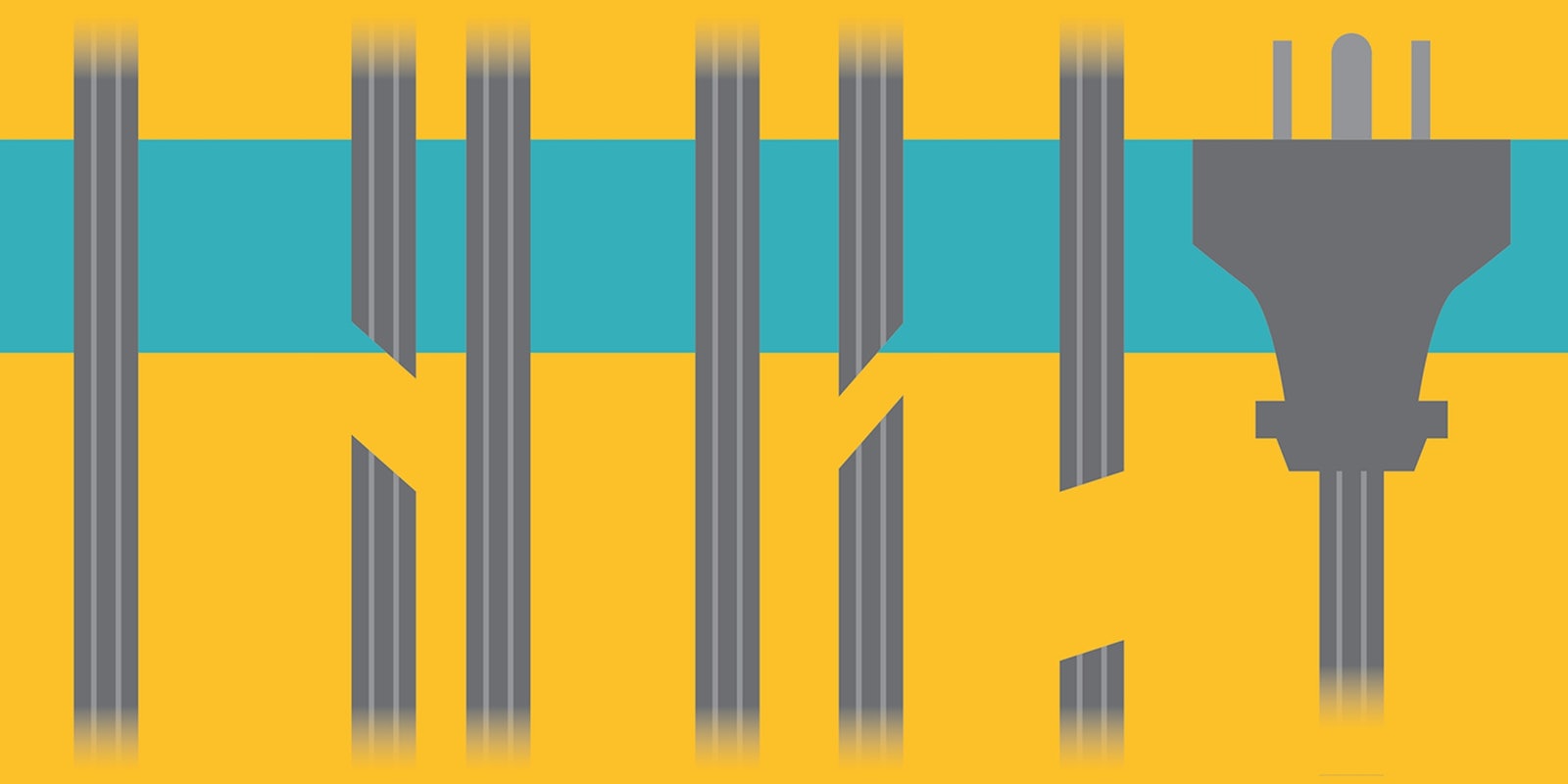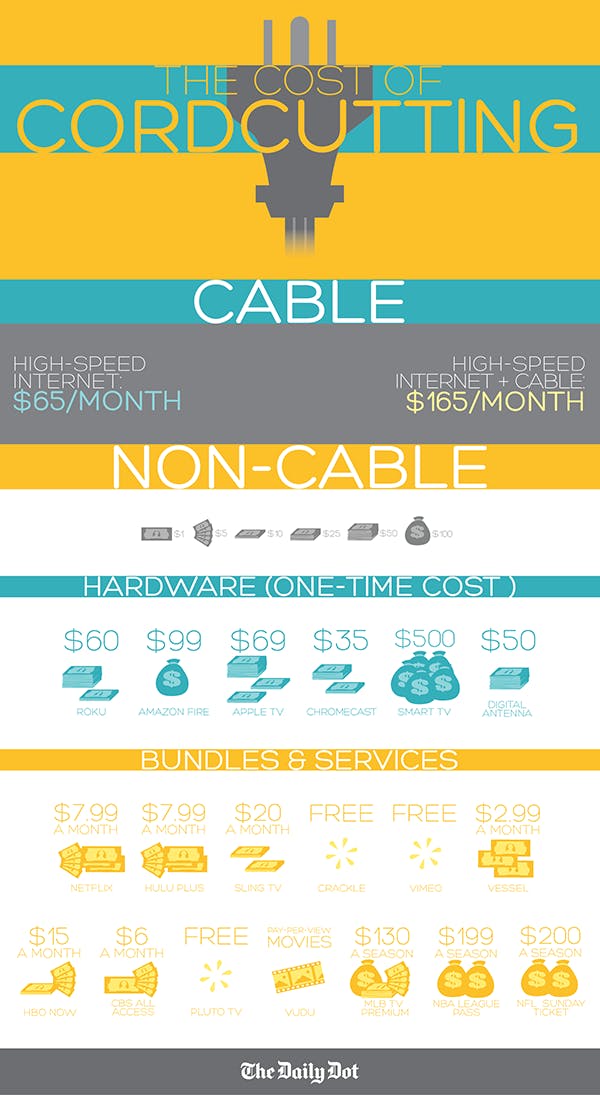Choosing a cable provider is the very definition of “the lesser of two evils.” There’s nothing like the news of the failed Comcast–Time Warner Cable merger to bring that into sharp relief. And the desperate desire to escape that terrible choice is why the notion of cord cutting is growing in popularity.
Research from MoffetNathanson states in 2014, 1.4 million U.S. TV homes ended their pay-television service, with another 4.2 percent saying they expect to join the ranks of cord cutters in the first half of 2015. More than a million of those who gave up on cable come from the two leading service providers: you guessed it, Comcast and Time Warner.
While consumers long have complained about the rising cost of pay-TV service, bad customer service, and a lack of choice, it wasn’t until the proliferation of high-speed Internet bandwidth and the advent of streaming services such as Netflix that there were options beyond the set-top box. With “over the top” streaming boxes such as those from Roku, Amazon, and Apple TV, cable subscribers are now provided another option in what many consider a one-sided deal.
But this cord cutter thing is tricky. For one thing, it depends on what streaming viewer camp you belong to. For cable guys wanting to ditch the box, there will be sacrifices in both choice and convenience. There also are some fine-grain decisions that must be made on selecting the right streaming box for your needs, what level of bandwidth you will need to enjoy a satisfactory streaming experience, and what services you want to buy to replicate your previous programming choices.
There are alternatives to cable TV, and for those who never have subscribed to cable, streaming TV opens up a world of untold excitement and adventures. Perhaps it’s too much of a good thing?
The true cost of cable
The simplest way to think about cord cutting is to compare the components of a streaming package that would be similar to the same services via cable.
Using my Time Warner service as an example, my total bill for high-speed Internet and cable is $165. That includes monthly digital service for $64.99, which includes DVR, more than 200 channels, and a set-top box. It also affords me the ability to watch my channels on my mobile services, but with the caveat I only get the entire selection if I am in my home. The key part of that grand total is the $64 for high-speed Internet, which provides up to 300 Mbps service.
With many combo premium service bundles available (HBO, Showtime, Starz, etc.), it’s nearly impossible to attach prices, but they list out as follows: HBO (20 channels), $9.99 a month; Showtime (17 channels), $9.99 a month but currently is offered free; Cinemax (15 channels), $9.99 a month; and Starz (12 channels), $9.99 a month.
Time Warner also offers pro sports packages, including MLB Extra Innings for $195 for the season, Web access to the service, and Sports Pass for $8.99 a month, which includes premium college sports and soccer matches. Cable does not offer access to NFL games in season, as DirecTV owns exclusive rights.
Included with Time Warner’s subscription is streaming access to a number of standalone “TV Everywhere” apps such as HBO Go, Showtime, Lifetime, A&E, the History Channel, and live feeds from ABC.
To sum up, for my monthly $165 I receive digital cable, HBO, and Showtime (which is free). Somewhere in there, I’m paying for a few advanced programming tiers, but only for a few channels. Like most cable subscribers, I spend plenty of money on a number of networks I have no intention of watching. For example, until the other day I didn’t know we had access to a music network called Revolt (owned by P. Diddy). Good to know, but definitely not my thing.
How to cut the cord
Moving from the dark side of cable to the bright light of cord cutting, let’s take my $165 monthly budget and see what that will buy in the world of streaming.
First, we take $65 off the top for high-speed Internet access. The 300 Mbps is more than sufficient for HD-quality picture. For the streaming box, let’s go with the newest Roku for $85. On the assumption it will continue to provide leading streaming networks, we can amortize the cost for two years, taking $3.50 off per month. That leaves us $96.50 for additional content.
Next, in order to get local network TV channels, we will need a decent HD indoor antenna. For a one-time cost of $40-50, the Mohu Leaf family of products is great, and that gives me ABC, NBC, CBS, Fox, PBS, and some indie networks. Keep in mind, receiving local channels does not include the ability to record them, so your options are to set your alarm clock or buy a $200 home DVR unit.
So with my remaining $95.50, my first purchase is Hulu Plus because it allows me to watch many of those shows I could not record at my convenience. While it’s not great for original content, Hulu Plus also includes some good British TV shows (such as Doctor Who), older network shows (The Rockford Files, Airwolf), and the occasional interesting movie.
For the best original content, the next payout goes to Netflix for $7.99 a month. If you are new to the service, the cost is $8.99. A Netflix subscription offers original shows, like The Unbreakable Kimmy Schmidt, House of Cards, Orange Is the New Black, and a string of new shows in production. I find the TV and movie choices vary in quality from month to month with the occasional surprise, but mini sports documentaries such as ESPN’s 30 for 30 and strong narrative documentaries such as Into the Abyss offer great viewing options.
With more than $79 left in the till, we head over to Sling TV, where we will drop $60 for the entire slate of programming. Sling is available on every streaming box as well as via a mobile app. The basic package is $20 a month and includes (according to the service’s site) ESPN, ESPN2, AMC, TNT, TBS, CNN, A&E, Lifetime, History, Food Network, HGTV, Travel Channel, Cartoon Network/Adult Swim, Disney Channel, ABC Family, IFC, H2, El Rey Network, Maker, and Galavision. For $5 more, we can add the sports extra for those specialty ESPN nets (BuzzerBeater, News, Bases Loaded) and the SEC network for those LSU and Florida State fans.
The next $15 nets you Lifestyle Extra (DIY, Cooking Channel); World News Extra (Bloomberg, France 24, Russia Today), and Hollywood Extra (three EPIX movie channels and Sundance Channel). The last $15 goes for Sling TV’s HBO service, which is the live airing of the pay network’s programs such as Game of Thrones and True Detective. Sling’s version of HBO does not currently offer HBO on demand.
With the remaining $19, we can buy a lot of popcorn or spend it on three or four PPV movies. So for less than a month of cable, we are able to build a robust slate of content with a little wiggle room left over—though perhaps not as much as former cable subscribers might have hoped.
The choice is yours
There are plenty of considerations to ponder in the seemingly complex world of cord cutting. Despite what many think about cable, the service itself is fairly reliable; streaming TV can have issues such as flaky reception when too many users are on at the same time. Just ask Sling subscribers who were interrupted while watching Game of Thrones. And in the case of problems with your streaming box, you are left to your own devices to resolve technical issues.
By no means is the cord cutter package I suggest absolute. For example, by spending more on your streaming box and grabbing an Amazon Fire, you get Amazon Prime content, which has a growing list of original shows such as Transparent and Mozart in the Jungle. If you buy an Apple TV box, your first three months of HBO are free. There are tradeoffs everywhere in the cord cutting jungle.
No matter what cord cutting package you devise, there is a lot of free content to supplement your choices. The best of the complimentary lot are YouTube, Vimeo, Shout TV, Twitch, Crackle, and Pluto.TV.
The choice is yours—cord or no cord. Either way, there’s more to watch than your mother would approve of. Don’t sit too close to the set, and don’t forget to do your homework.
Illustration by Max Fleishman



